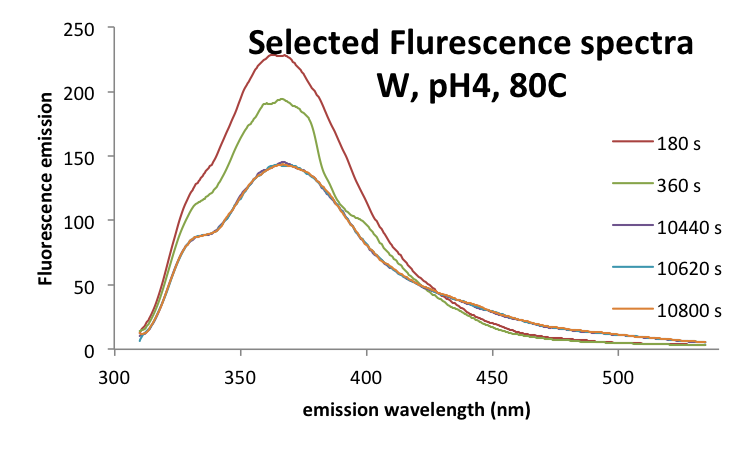|
Objective
Take fluorescence scans of tryptophan and tryptophan+AuCl3 at 80C and pH 4.
Description
- Add experimental record here. Include what, how, and why...
Data
Stock Solutions
- Tryptophan
- 3.00 mg tryptophan
- to 10.0 mL of water
- 204.23 g/mol
- 1.47 μM
Reaction solutions
- Just Tryptophan (3.0 μM tryptophan pH 4)
- 300 μL 1 mM HCl
- 6.1 μL tryptophan
- 2694 uL water
- 3.0μM tryptophan, 0.25mM AuCl3, pH 4
- 300 μL 1 mM HCl
- 6.1 μL tryptophan
- 201 μL AuCl3
- 2493 uL water
UV-Vis W samples
I took UV-Vis spectra of the samples before and after the fluorescence scans

Fluorescence W samples
- Fluorescence measurements
- 290 nm excitation, 10.0 nm slit width
- Emission: 310-540 nm, 10 nm slit width
- 100 nm/min
- 1 scan every 3 minutes




UV-Vis W+AuCl3 samples
I took UV-Vis spectra of the samples before and after the fluorescence scans

Note that there is not a hint of purple color in the sample after the reaction.
Fluorescence W samples
- Fluorescence measurements
- 290 nm excitation, 10.0 nm slit width
- Emission: 310-540 nm, 10 nm slit width
- 100 nm/min
- 1 scan every 3 minutes
Note: the second to last scan didn't save properly.






Notes
This area is for any observations or conclusions that you would like to note.
Use categories like tags. Change the "Course" category to the one corresponding to your course. The "Miscellaneous" tag can be used for particular experiments, as instructed by your professor. Please be sure to change or delete this tag as required so that the categories remain well organized.
|  Biomaterials Design Lab
Biomaterials Design Lab











